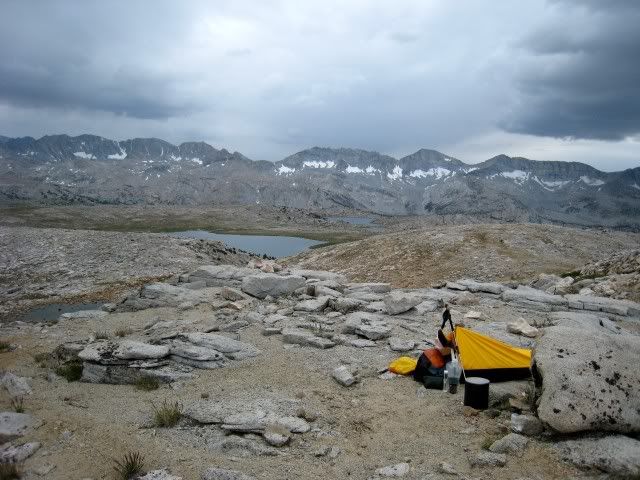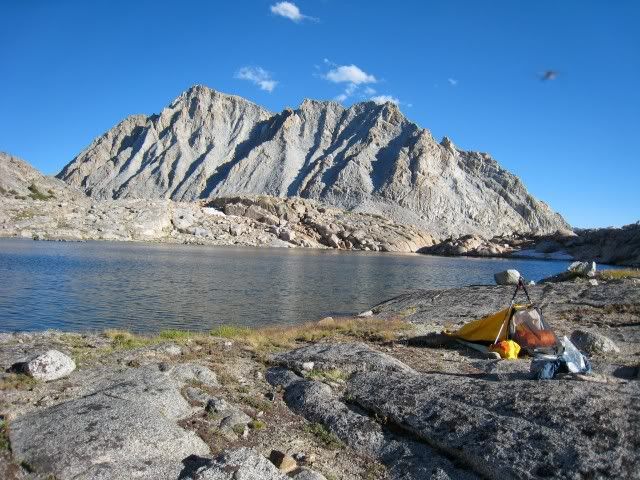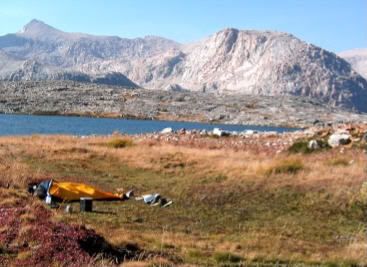I am considering purchasing my first bivy bag for summer use when I go solo, but I would prefer not to spend a fortune for one with built in bug netting. Do any of you sleep with your head exposed? Do you think a mosquito head net and a beanie over the ears is sufficient to ward off creepy crawlies? Thanks!
PS: Did sleeping in the open freak you out the first couple of nights? Are you over it?
You've probably already hit the trail to learn these things on your own, but in case you haven't or you or others could use some additional insight, here's my 2 cents:
I spent 4 months hiking the AT. It got old really quickly setting up my tarp or my hammock tent. As a result, I became fond of bivouacking it.
In the beginning, I did have this fear of camping out in the open that you mentioned. Fear is overcome by necessity and experience. You will learn your fears are largely just imagination working overtime. The exhaustion of hiking 20 miles a day gave little space for my nocturnal anxieties, as I quickly fell asleep, despite noticing several pairs of glowing red eyes staring back at me from a distance. In a short period of time, you will develop an understanding that animals will make room for your presence and come to feel a natural sense of belonging in this environment. A week is not unrealistic.
I used a cheap Coleman head-net, an Outdoor Research Radar cap sometimes combined with a polypropylene balaclava with good results, keeping the rest of my body down inside my Phantom 32 bag. I used a 24" wide strip of ripstop emergency blanket for a ground cloth and a 20x48" Thermarest air mattress for a pad. The bag shielded me from mosquitoes, and the cap kept the head net off my face. I had no bites on my ears, perhaps because my cap was sprayed with Permethrin. Since I mostly slept on windy vistas and cool areas near water, the bag wasn't too warm even in summer heat. Just don't fluff the down when it's hot.
It's a good idea to spray Permethrin on your ground cloth to keep ticks from getting to your sleeping gear, and to kill anything under it.
I carried a weather radio to plan dry bivouacs. My 7oz Golite poncho was an option as a rain tarp when I couldn't otherwise get into an AT shelter. Pyramidal style pitching with back to the wind ensured my bag stayed dry.
Sometimes in an unprotected bivouac, I did wake up to a few raindrops pelting my face, which resulted in a sudden panic to get the tarp over my bag to keep the down dry. This is the main reason I'm considering a bivy bag now.
The other reason is, in summer weather, a sleeping bag is more of a luxury item than a necessity. A bivy bag combined with the thermal layers I already carry for alpine transit and a simple SOL reflective emergency blanket should extend my range down to 45-50F and reduce my pack weight the 23oz my sleeping bag weighs. The two layers of the bivy bag, thermals and socks should prevent mosquito bite-through.
Most "waterproof" bivy bags I've researched are not adequate enough in the heavy rain of thunderstorms, although they are sufficient for light to normal rain.
A material rating of 1200 mm of hydrostatic head means the material can be immersed to a depth of about 3 feet of MOTIONLESS water without penetration. But as this water begins to move, an additional component of pressure called "dynamic pressure head", also quantified as distance, develops. Even when your bag is not immersed in water, the water of rain can develop enough pressure from movement to penetrate the hydrostatic rating of the material.
You need about 1200mm of hydrostatic protection in light to normal, free falling rain and 3600mm protection for a heavy rain (thunderstorm). A margin of safety is advisable to ensure you stay dry in your gear, as wind gusts add to the pressure of the rain.
Tyvek (olefin made from polyethylene or milk jug plastic), which is what the SOL Escape Bivvy is made from, has a rating usually between 1000-1200mm. I've seen numerous "waterproof" bivies sporting only this much waterproofing. Obviously a tarp is still necessary in this case, as a heavy thunderstorm will leave you soaking wet in your bag.
I want to shed the weight of a poncho/tarp. Getting in an out of a poncho, especially during intermittent summer rain, is not only a hassle, but hiking in it is hot, even with all the ventilation available. The sweat can really pour. I prefer the breathability and quick deployment of a trail umbrella instead, which is also useful for keeping cool in direct sun. Less sweat equates with drier hiking, too. The umbrella can also be deployed as a face cover for the opening of the bivy.
As of this present time, the Montbell Breeze DryTec UL bivy is my favorite lightweight choice. It's rated initially at 25,000 mm of hydrostatic head even after 20 washes. That is more than adequate for heavy rain. Breathability is extremely good at 15,000 gm/m2 in 24 hrs. Claustrophobic campers might prefer a short waterproof side zip which the UL bivy doesn't have (my only complaint), but one can be installed aftermarket. The 25,000mm rating of the Breeze DryTec material should be able to withstand penetration of rain up to just under 50mph according to my calculation.
Although I've used only a mosquito head net in the past, I'd like the option now of pushing the bivy down for hot nights and still having bug protection. 2 oz of Permethrin sprayed bug net fashioned into a half upper body tube with some elastic at the waist and thin dyneema cord to hold the netting up might work to keep netting off hands and face. If the cord slides through a narrow eyelet into the tubed netting, a spring-loaded cord lock can be used to take up tension from inside the netting. I can still bivouac on rock outcrops or treeless areas if I run the cord to higher ground or to nearby trees or bush.
The only drawback to bivy camping in heavy rain I can see is if your breathable bivy sack material uses a DWR coating on top of the porous waterproof barrier that can wear out. I have been advised that in this case, if and when the fabric "wets out", it can't breath, and internal condensation from sweat moisture develops. If you can't dry out your gear because of days of persistent rain, it could lead to a great deal of clammy, uncomfortable bivouacking and wet, useless sleeping bag down.
I'm still investigating this, but it seems to me that a porous material like Tyvek that has no DWR coating, can't "wet out" unless of course wind driven rain or depth of water first forces water through its narrow pores. It seems to me the only time water can wet out the exterior surface of a breathable waterproof fabric is if the fabric is laminated to a non-waterproof fabric on the top surface (like simple nylon) that could "wet out" without pressure. I'm not all that familiar with the construction of these materials, so If anyone has any insight here, I'd appreciate your input.


